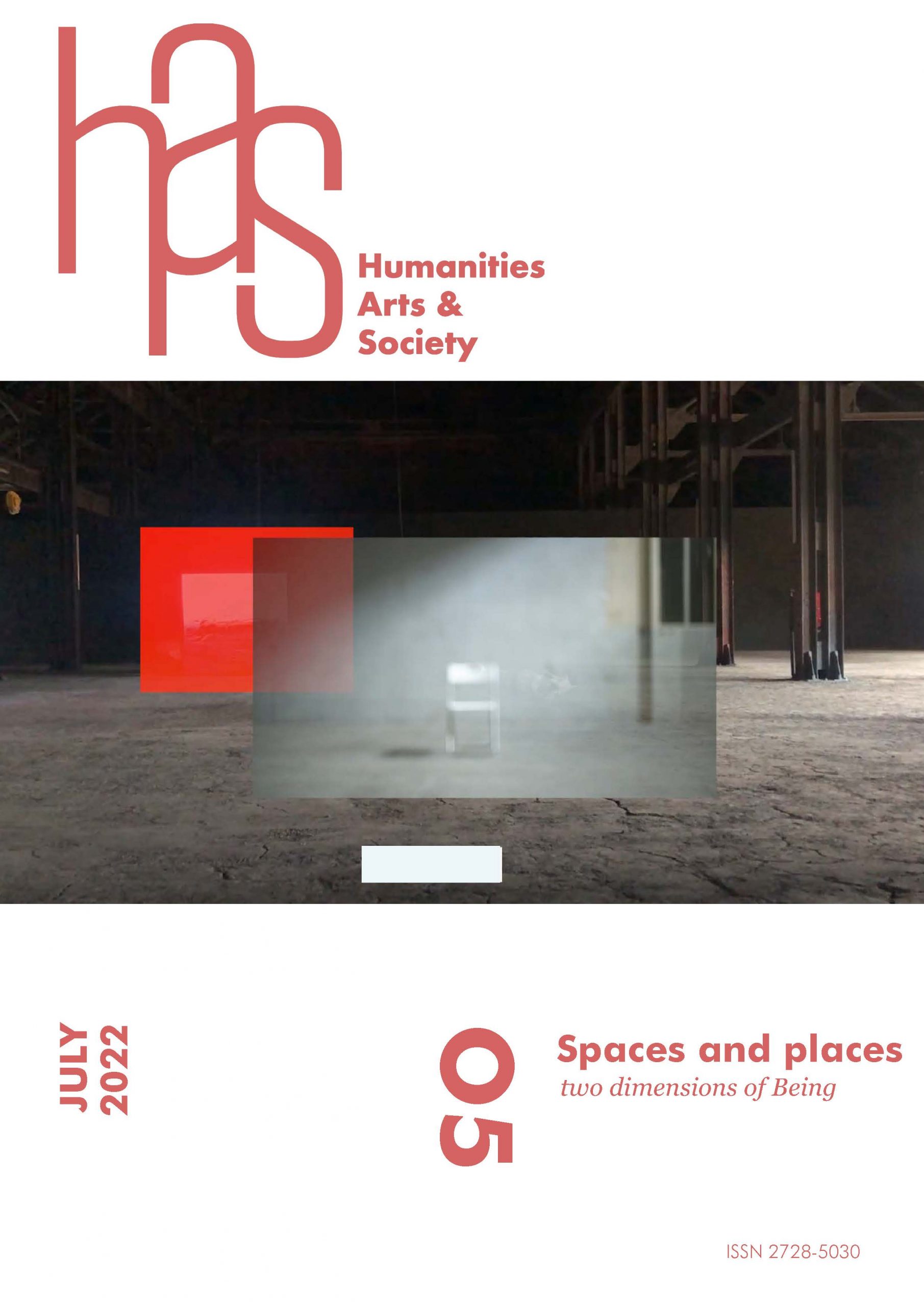The site-specific project Market—A Place For Everything, A Place For Everyone was my third curatorial initiative in Gyumri, Armenia. Invited by the GUrban team to contribute to the Ground Art Fest and given carte blanche, I was inspired by my experience of the city, which had evolved into a true emotional bond with the place and people.
The idea of the Ground Art Fest was to engage the urban realm and motivate the participants to do field research and create public art interventions. I chose Gyumri market for the artistic statements. My decision caused some stir among my colleagues, and even provoked strong discouragement. Many tried to persuade me to abandon the concept, for it could cause dangerous confrontations with the market people. Several supported the idea, but strongly recommended building relationships with the market tenants ahead of the project.
I followed this advice, and spent a week at the market, meeting vendors, farmers, security guards, landlords, and customers. We talked about the place, drank much coffee, and discussed the art to be performed in the narrow passages between the market counters. This completely ruined the accepted cliché about ordinary people being unprepared for, even hostile toward advanced art. On the contrary, they were genuinely interested to see whether art could happen at the market, and wondered about what a performance might be. Some of the tenants provided us spaces to store our equipment and assured us of further support. By the end of the week, all of the vendors knew my name and were anticipating the start of the festival.
Historically, the market was not only a place of trade and exchange, but a slit in the urban fabric through which new and wonderful things poured into the city. It used to be an extraordinary realm tolerating a mix of local and overseas merchants, foreign dialects and languages, peculiar goods from abroad, and the bizarre dress of their importers. Apart from purchasing products, the citizens of the city would receive world news, meet and observe people of various social strata, participate in cultural diversity, discover previously unknown things. The market was an enormous social platform, sanctioning processes otherwise dissociated from everyday life. The unique porosity of the market facilitated the rise and development of such phenomena as minstrels and Commedia dell’arte in the European tradition, while in Arabic culture, the storytelling at bazaars was believed to give rise to the fabulous tales of One Thousand and One Nights.[1]

Despite serving as a scene for folk entertainment, the market wasn’t a theatre—there was no fixed border between performers and spectators. Both were actively involved in performances and co-created them. In Bakhtin’s study on the culture of carnival and market feasts, the scholar specifies the “living” mode of folk spectacles—instead of acting, one would live them in exciting togetherness.[2] The market environment was originally engaging and reciprocal, with all of its actors making contributions. It hasn’t become a relic; on the contrary, markets have preserved their energy and capacity for hospitality, communication, and inclusivity. As Arsen Bobokhyan and Levon Abrahamian state, in the preface to Market Beyond Economy, “… modern marketplaces are not only places of economic exchange but also thriving microcosms of social relation.” The editors compare markets to “the childhood of humanity,” which I find both poetic and stimulating for its reflection on what can be learned within and from the market.
In Gyumri, the market initially played a critical role in the culture. A city of craftsmen, Gyumri would employ the market as an important scene for displaying their know-how. My tour guides, local historians Liana Nersisyan and Azniv Tadevosyan, told me that in the 19th century, masters settled down close to the market, and an intense network of workshops emerged alongside the trade. Thus, the market performed far more than an economic function—it represented the very idea of the artisanal city. Anthropologist Gayne Shagoyan writes that the rich mythology of Gyumri around handicrafts was essential for the construction of the local identity, and has been lately re-actualized in films, street-naming, statues, and festivals.[3] Nowadays, unfortunately, the work of artisans has almost vanished from the market, displaced by mass-produced items, but one can still can find several metal workshops there.
Nevertheless, the market hasn’t lost its symbolic connection with the masters. In Lusine Ogandganyan’s book Love-obsessed Gyumri, there is a short piece titled “I am cooking a story.” Written in a Gyumri dialect,[4] it describes a grocery shopping trip at the bazaar which turns out to be an adventure. Amazed by personalities she meets and conversations in which she participates, the author calls the vendors “masters,” admiring their eloquent wit and temperament. Interestingly, Shagoyan refers to eloquence and bragging, features traditionally attributed to Gyumritsi, as potentially inherited from the craftsmen promoting their goods at the market.[5] In this way, the market could epitomize the very essence of the city, and bridge its past with present.
As it did historically, the market appeared to provide a perfect platform for reaching out to diverse audiences. Having curated two institutional exhibitions in Gyumri, I observed both times the same crowd attending the shows. Yet the market realm seemed to be a great opportunity for encountering and engaging with people who otherwise would hardly ever come to a gallery—not because of their ignorance, but because contemporary art seems to them to be an elitist enterprise. There is a rumour about Gyumri that the locals criticize art projects, disapproving of the wasted budget money that could be used for improving livelihoods. Despite pervasive poverty, this rumour is far from the truth—Gyumritsi cultivate a deep appreciation of art and awe of artists.
However, by calling the market a perfect platform, I don’t mean exclusively its crowded diversity. Much more important is a unique social climate based on grassroots processes. Considering its huge size, Gyumri market is decentralized—there is no management structure or hierarchy. There are nominal heads of certain areas, although it turned out to be irrelevant to coordinate any plans with them. After searching for a director of the market, I was brought to a large office with ersatz gilded furniture, and was assured by him of total support for the project. Nevertheless, all details had to be settled with loaders, drivers, vendors, and security guards, because they were the ones who decided what could or couldn’t happen at the market. When we needed to dim the lights in the main pavilion for a screening, once again I was introduced to a person in charge, who met me in his improvised bureau decorated floor-to-ceiling with carpets, where he was lying on a divan and smoking. He poured me tea and explained that if I wanted to dim the lights for an hour, I had to go and talk about this with the people in the pavilion. If they were fine with it, we might carry on. Otherwise he couldn’t do anything to assist. The market appeared to be a place where its actors were responsible for the functions of the public realm.
Alongside the farmers, coming irregularly and laying their products on the floor or on cardboard boxes, filling up the roads and free spaces among the booths, we observed vendors who would arrive with a small table and set up an impromptu stall in a vacant spot. In his analysis of the street trade in post-Soviet Yerevan, Aghasi Tadevosyan describes various forms of unauthorized trade, including the popping-up of tables to sell from, colloquially known as seghanik.[6] While in the capital, seghanik has been displaced by mini-shops and supermarkets, in Gyumri it keeps flourishing. The author refers to Lefebvre’s concept of the right to the city and considers the spontaneous, unsanctioned street business that thrived in the 1990s to be a bottom-up initiative of the citizens for performing a vision of the public space. In this way, Gyumri market can be seen as an open ground for citizens to fulfil their right to the place.
During the performances, one charismatic lady with a seghanik became our passionate advocate and fought with opposing regular vendors. Nobody dared point out her precarious position or doubt her right to argue what would be tolerable or despised at the bazaar. This reaffirmed the participatory, self-organized community structure of the market realm. It is even more interesting to reflect upon its location, right next to the buildings of the city authorities—the market stretches out almost from the town hall and loops to its backside. Hamlet Melkumyan writes about the Vernissage marketplace in Yerevan, “… this Fair lives in ‘another time’ from the government building in the immediate proximity to it. They ‘do not see’ each other.”[7] One could say the same about Gyumri bazaar.
Drawing upon this manifold discourse, the project Market—A Place For Everything, A Place For Everyone was conceived. The title was meant to reflect the inspiring openness and inclusivity of this public realm. Activating togetherness, sharing, and collective artmaking, the invited artists were encouraged to research the capacity of the site for communication and creative practice.
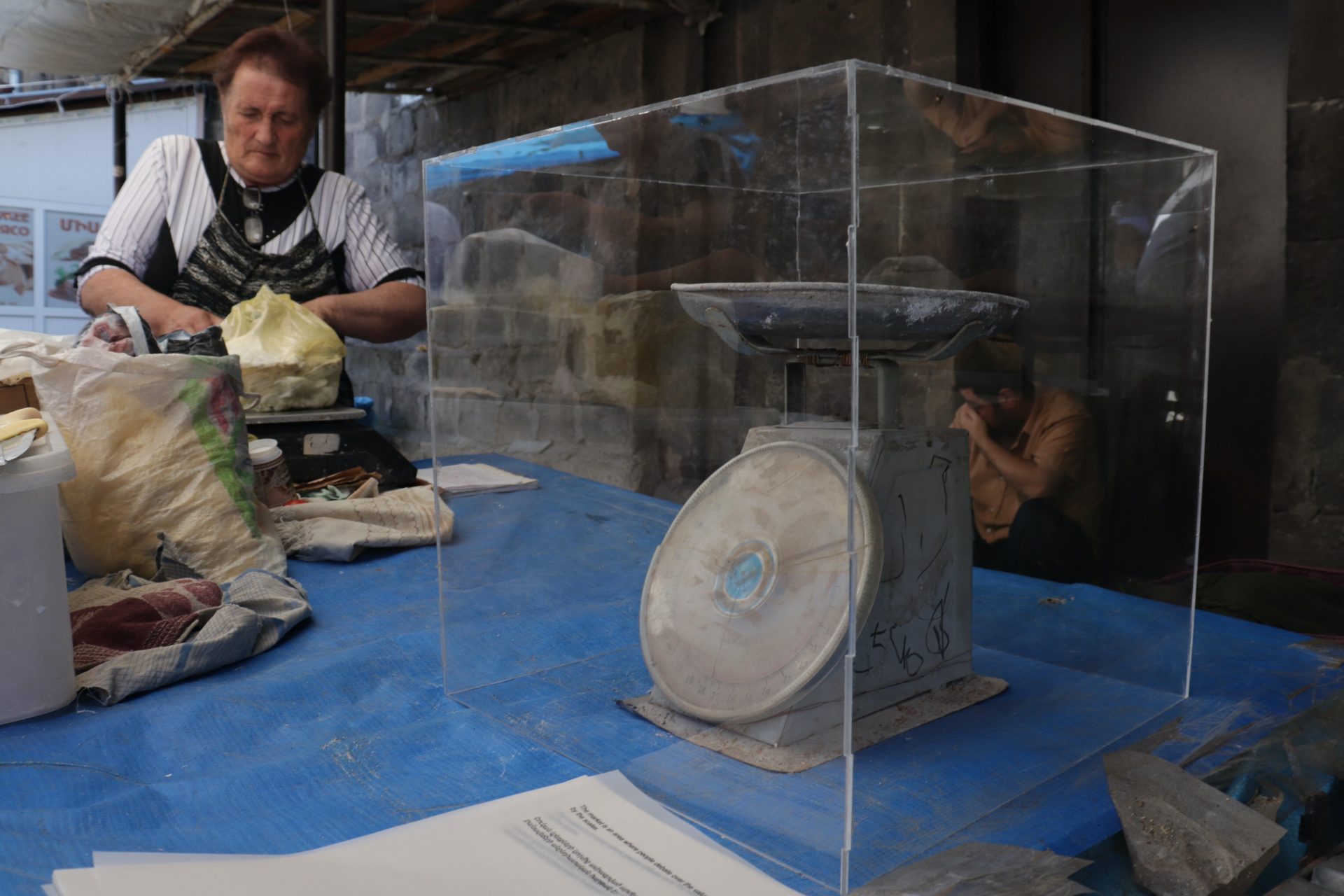
I should start with the performative installation of Hovhannes Smoyan, the first project to be integrated into the market reality and the last to be demounted, functioning during the entire festival. Hovhannes deals more with concepts and narratives than objects, and provides a case study on an issue. His installation Dehumanizing the Scales traced the transformation of the main symbol of market and trade—and, broadly, economies—scales. Found tools (still widely used at Gyumri market) were showcased in transparent cubes on the counters, among the wares, at the very places where customers try, choose, and purchase products. It was not a reference to museum vitrines, however, but a gesture of extracting the scales from the environment while visually keeping them within it. The objects were accompanied by texts elaborating on the meaning-in-transition of the scales. Originally a symbol of justice, the perception of scales has shifted toward one of an instrument that can’t be trusted because it has been widely involved with fraud at the markets. As the Armenian proverb says, “One eye is enough for the seller, a thousand eyes are not enough for the buyer.”[8] Yet Hovhannes’s intention wasn’t to accuse, but to critically reflect the radical change of the meaning of the object during its journey.

A different approach was taken by Mariam Ghalayan. A trained theatre director, she is pushing the borders of theatre performance and delving into various body practices to unlock the full capacity of physical acts and presences. Her performance Documentary Self-discovery intervened in the collective body of the market and created a radical experience for understanding one’s own corporeality. A red rope, stretched for tens of metres in the market’s alleys, referred to the umbilical cord, while a heavy stone represented the body. Placed at several spots, metal buckets were filled with water for ablution and purification. During the performance, Mariam rolled a massive stone along the red path—struggling, suffering, crying, and laughing. It was a way that should have been walked, crawled through, no matter how hard and long it was. She made brief pauses to wash off dirt and debris from the stone and her hands. She appeared to ask the question: To live means to have a body, but how does it feel to have one? The spectators connected somatically to the performer’s striving, and endured together with her that way through the market, stimulating an intense collective musing on the labour of being.
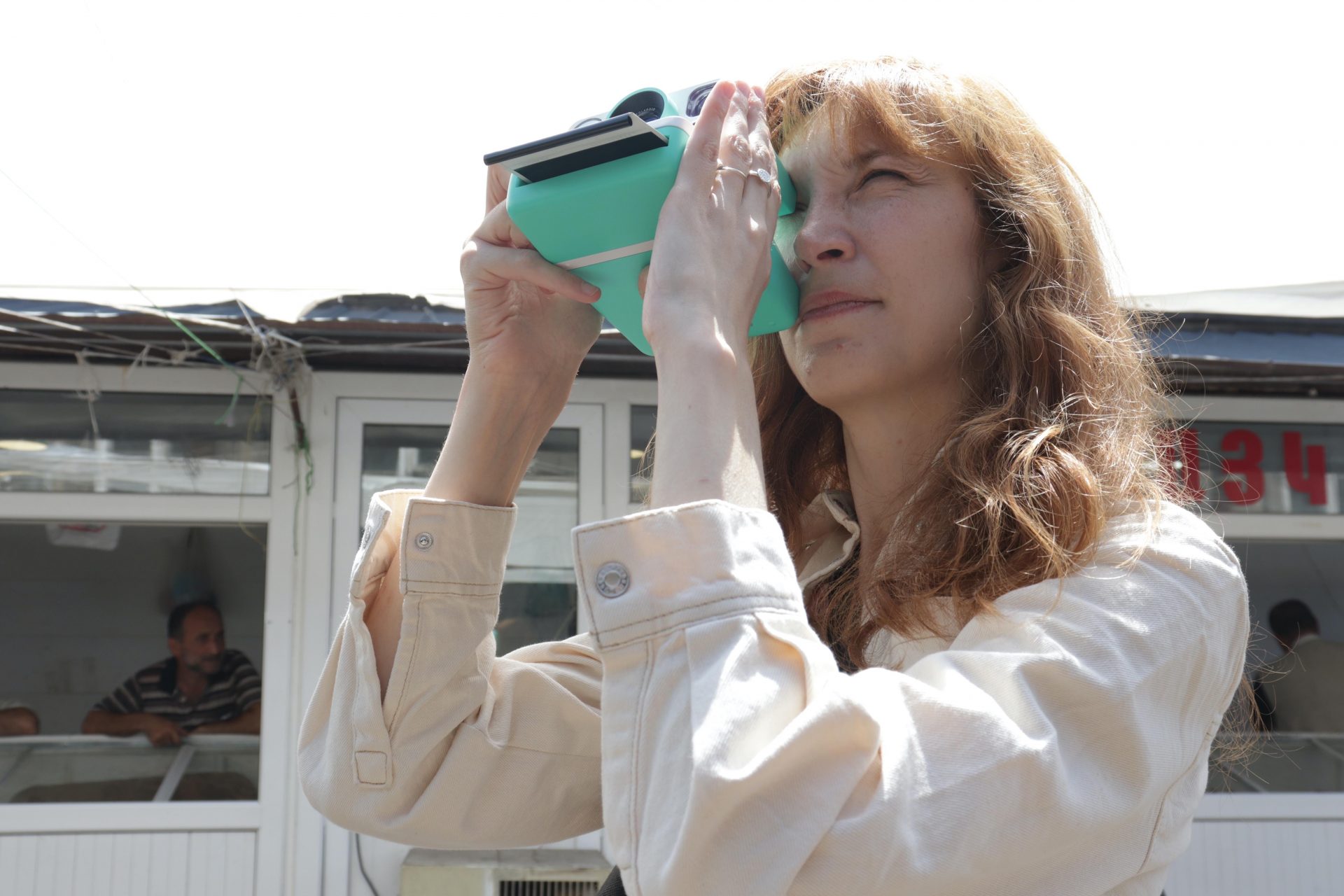
Gohar Martirosayn, who had spent her adolescence in Gyumri and developed emotional ties to the city, created the video performance Archaeology Of The Gaze. For it, she reconstructed her personal memories of Gyumri market, and researched how spontaneous photo and video fragments could externalize the aura of the place—its genius loci. Using cameras as estrangement filters, Gohar applied double disconnection. First, she made Polaroid© snapshots while walking through the market, capturing its random parts and corners, then she filmed those pictures scattered around. Her watching was mediated by technology, as she transferred to the devices the very performance of perception. And suddenly, it produced an authentic feeling of the market, a gaze from within, a daydream. Later, the final film was screened in the market pavilion, together with Polaroid© prints exhibited on the counter. In this way, the artist returned the collected visuals to their original environment and re-observed them, together with the vendors.
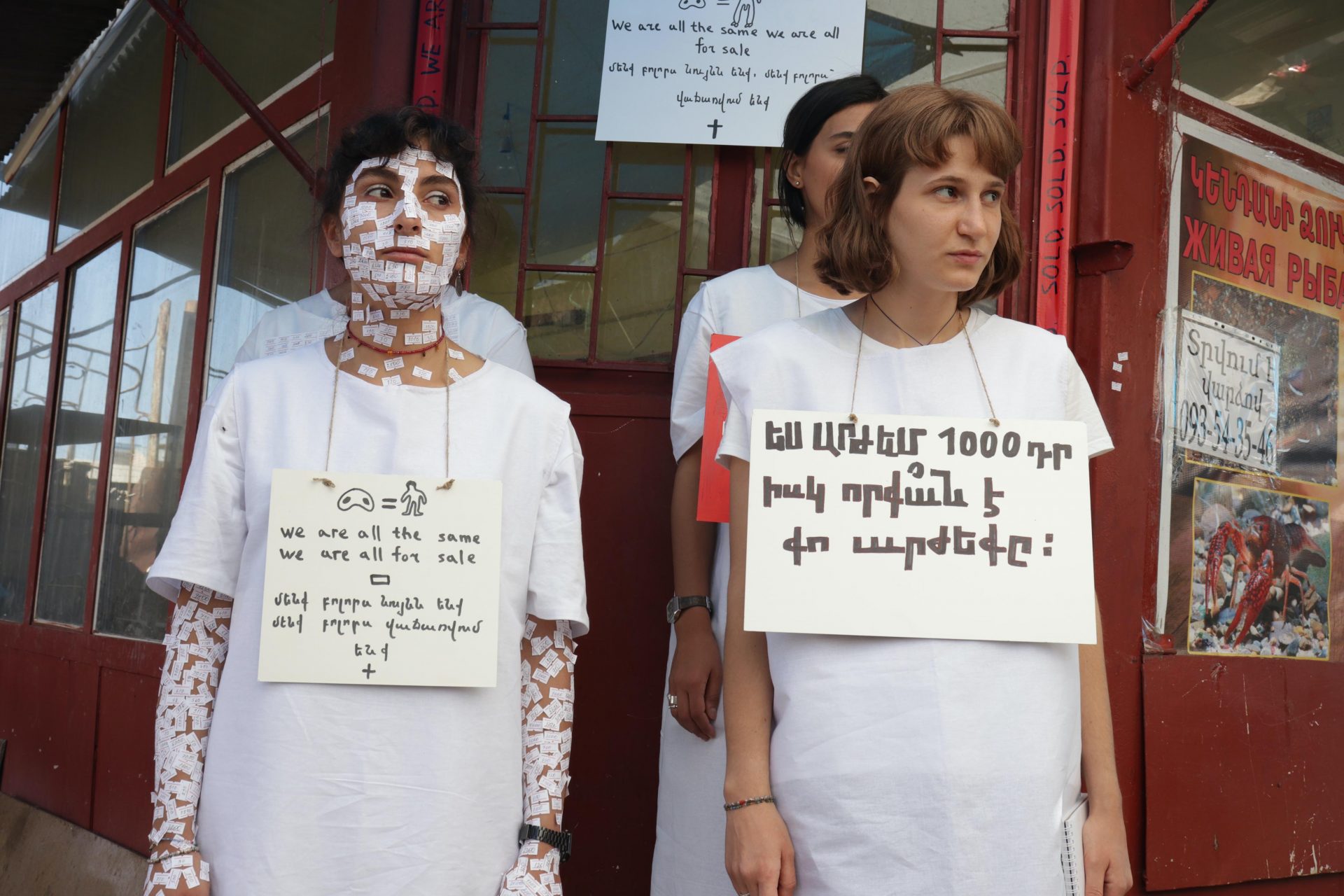
Kima Gyarakyan did the performance + = –, which manifested the capitalist situation of total consumption, inducing the valorization of people—our bodies, experiences, dreams. She exposed the performers as merchandise. Dressed in white robes, they carried price tags, sale labels, and “sold” statements. Placed on the counters, transported around in the market trolleys, the performers represented the transition from being a person to being a product. Their passiveness epitomized the voluntary withdrawal of counteractions toward the capitalist machine, and terrifying consent to be processed and converted into market commodities. Kima’s performance polarized the bazaar community, as some members felt offended—the act of demonstrating people along with wares hurt them deeply. The Armenian proverb nevertheless says, “In the market a spirit is sold with goods too.”[9] The performance triggered long and passionate disputes among the vendors. We spent the following days in long conversations about Kima’s message. At the end of the festival, different people stopped me with the words, “I’m not a thing, I have a heart, they can’t buy it.” We all believed that the impact of the performance and the discussions it sparked galvanized important collective reflection upon the pivotal problem of modern economies.

Lilit Ispiryan’s project Untitled addressed the market as a playground. The artist was interested in the opportunity to play with and re-experience the public realm. Lilit spray-painted the statements “Market is a performance being performed” and “Market is a performance being observed” in black, right on the narrow paths between the stalls, as if marking the entire area of the market as a performance site. Then she handed out badges with roles written on them—along with the obvious “vendors” and “customers,” “storytellers,” “onlookers,” and “commentators” were introduced; all participants were free to choose. By taking on these roles, they became performers within the graffiti-outlined situation, and hence converted the market into a collective artwork, with its sounds, choreography, and architecture suddenly perceived anew. Exhausted with drudgery and sometimes ashamed of their work, the market people were inspired to take a different view of their difficult routines and re-imagine them to be a game in which they could switch roles and play them humorously.
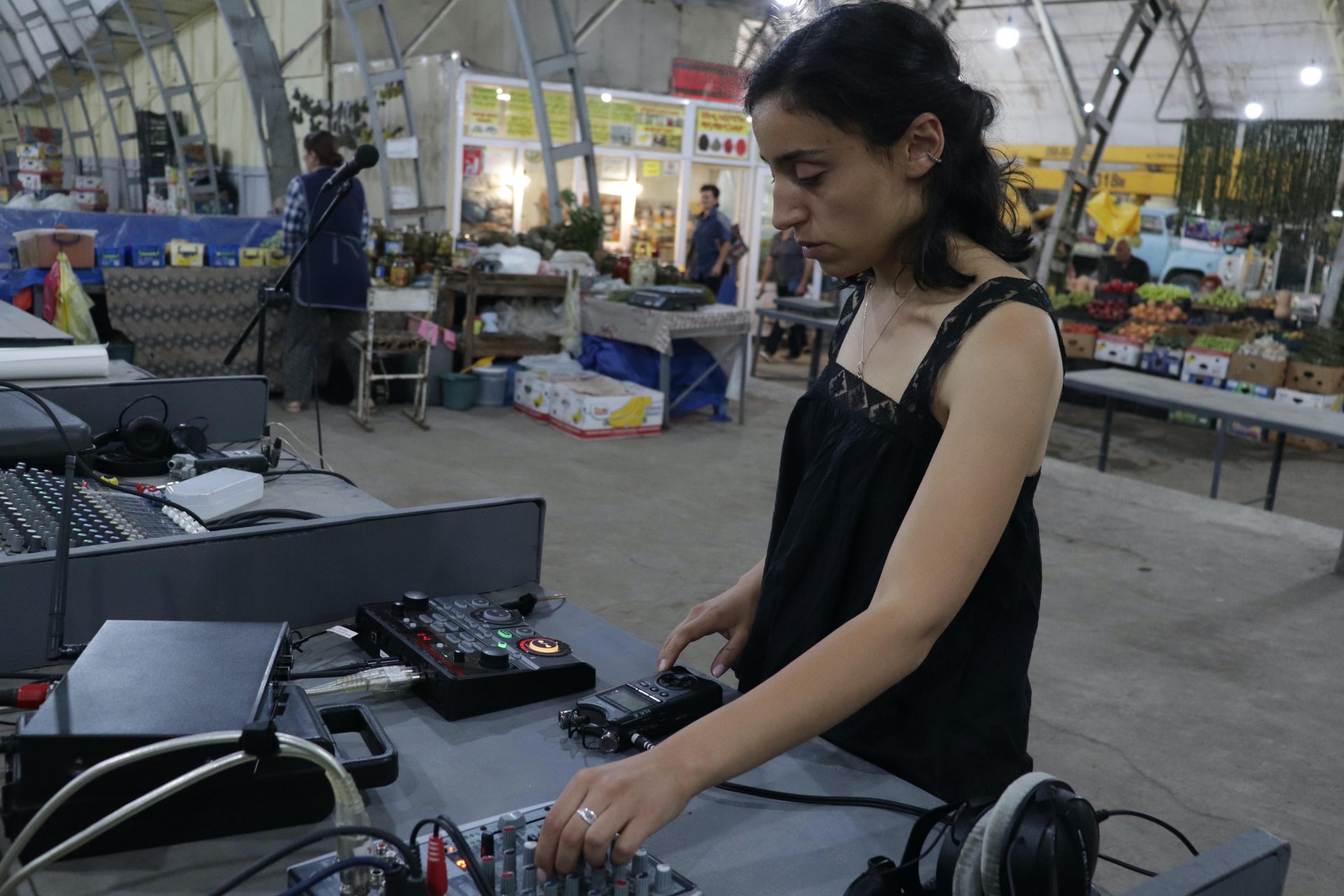
For their performance Listen, Maria Matinyan and Ophelia Flassig dove into the sonic landscape of the Gyumri bazaar and reinterpreted it via live sampling, performative mixing, and interactive recording. The artists engaged with the vendors, customers, and passersby, using a microphone to amplify the sounds of their activities—dialogues, haggling, oral promotion of the products, the jangling of coins and rustling of shopping bags. Discovered acoustic patterns of the place were re-assembled in real time and brought back as a composition with buoyant rhythm and bright vocal themes. Maria and Ophelia created a new sound layer on top of the intense original one. They used the noises of the market, not so much as raw material for a spontaneous score, but rather as an already existing piece, one which they analyzed and performed to manifest its complex musical structure. The second part of the performance included a blindfolded journey through the market—participants were taken around the pavilion and encouraged to listen and memorize the ambient sounds that they could re-enact afterward at the open microphone. It proved to be a wonderful new experience of the market’s vibrant cacophony.
These three days at Gyumri bazaar were overwhelming with artistic energy and emotional response from the local community. It was honestly a curatorial challenge to balance providing the artists with everything they needed to fulfil their ideas, being their advocate, and even safeguarding their actions, and at the same time performing diplomacy and interpreting their artworks to the market crowd. Despite demanding work on both sides, this project delivered a fantastic artistic energy that transformed reality toward visions of collective creating and imagining.
[1] Zohrabyan, Armine, “The Phenomenon of the Oriental Market,” Market Beyond Economy, National Academy of Sciences of Republic of Armenia, Institute of Archaeology and Ethnography. Yerevan, 2013: 110.
[2] Bakhtin, Mikhail Mikhaĭlovich. Rabelais and His World. Vol. 341. Indiana University Press, 1984.
[3] Shagoyan, Gayane. “Anthropological Notes on a City that Survived an Earthquake.” Laboratorium. Russian Review of Social Research 2.1 (2010): 160-181 (in Russian).
[4] The story was recommended to me by Liana Nersisyan and kindly translated by Gohar Martirosyan.
[5] Shagoyan, Gayane. “Anthropological Notes on a City that Survived an Earthquake.” Laboratorium. Russian Review of Social Research 2.1 (2010): 163 (in Russian).
[6] Tadevosyan, Agashi, “Influence of the Market on the Formation of Cultural Landscape”, Market Beyond Economy, National Academy of Sciences of Republic of Armenia, Institute of Archaeology and Ethnography. Yerevan, 2013: 30-34.
[7] Melkumyan, Hamlet, “Metamorphoses of the Yerevan Vernissage: From Cultural Event to Market”, Market Beyond Economy, National Academy of Sciences of Republic of Armenia, Institute of Archaeology and Ethnography. Yerevan, 2013: 19.
[8] Ayvazyan, Christina, “The Market in Proverbs and Sayings”, Market Beyond Economy, National Academy of Sciences of Republic of Armenia, Institute of Archaeology and Ethnography. Yerevan, 2013: 51.
[9] Ibid.
Liudmila Kirsanova (b.1988) is an independent curator and writer based in Vienna, Austria. She graduated with an MA in Art History from The Russian State University for the Humanities, Moscow. Her curatorial practice is focused on storytelling, autofictions, and the politics of belonging. She has participated in different research residencies, including The Whole Life Academy in Dresden, Salzburg International Academy of Fine Arts, and BLOCKFREI Curators’ Agenda in Vienna. In 2019, Kirsanova became the finalist of the Bonniers Konsthall Curatorial Award, Stockholm. Curating international and domestic projects, she has always been keen on promoting female artists, especially those from non-Western backgrounds.
Liudmila Kirsanova (b.1988) is an independent curator and writer based in Vienna, Austria. She graduated with an MA in Art History from The Russian State University for the Humanities, Moscow. Her curatorial practice is focused on storytelling, autofictions, and the politics of belonging. She has participated in different research residencies, including The Whole Life Academy in Dresden, Salzburg International Academy of Fine Arts, and BLOCKFREI Curators’ Agenda in Vienna. In 2019, Kirsanova became the finalist of the Bonniers Konsthall Curatorial Award, Stockholm. Curating international and domestic projects, she has always been keen on promoting female artists, especially those from non-Western backgrounds.
